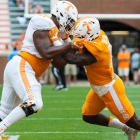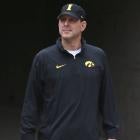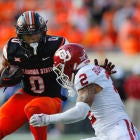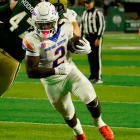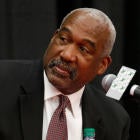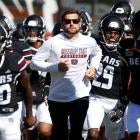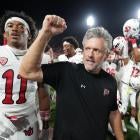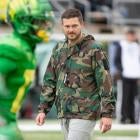
Jay Wilkinson was there for the birth of a workout. The Oklahoma drill didn't have a name 70 years ago, but it had a purpose.
"It was a pretty good way to determine pretty quickly who your tough guys were," said Wilkinson, the 77-year-old son of the man who laid one of football's practice foundations.
Legendary Oklahoma coach Bud Wilkinson died 25 years ago. His influence on the game lives on today even after the NFL last week banned the Oklahoma drill that Wilkinson created in the late 1940s.
Anyone who has at least played high school football has likely taken part in the drill. It is a football rite of passage. It has many variations, but at its base, two players line up against each other in a confined practice-field space.
Teammates gather around to witness football's version of gladiator battle. When the whistle blows, the combatants collide. One emerges from the one-on-one clash a winner.
"It's man-on-man and lining up and whipping somebody's ass," South Carolina coach Will Muschamp said. "That's what it all comes down to."
Take a good look because this staple of American male-bonding and team-shaping is on its way out. The NFL is asking its teams to get rid of it. NCAA medical personnel have at least had discussions about doing the same, according to Steve Shaw, the NCAA secretary rules-editor and the SEC officiating supervisor.
All of it reflects the ongoing player-safety movement across all of football: The best way to stay healthy -- indeed, the best thing for the game -- is to hit less.
"Even I know they're eliminating so much physical contact," said Jay Wilkinson, a former All-American quarterback at Duke in 1963.
The Oklahoma drill, then, is a sort of violent relic in a new age of awareness.
"That's what I grew up doing. Fourth grade, I was out there doing that Oklahoma drill," LSU long snapper Blake Ferguson said. "It taught you how to be a tough football player."
"My dad knew it would accomplish two things," Jay Wilkinson said. "It would determine which players were tough enough. The second aspect of it was quickness and speed and reaction to movement."
At last week's SEC spring meetings, CBS Sports asked coaches from college football's top conference about the Oklahoma drill and its future. In the league that might as well have invented hard-nosed football, the Oklahoma drill sounded like it may be on its way out.
"I don't know how it makes you a better football player." -- Tennessee coach Jeremy Pruitt said
"We try to eliminate as much of that as we can." -- Kentucky coach Mark Stoops
"It's been done at places I've been. It's just not something we cared to introduce." -- Mississippi State coach Joe Moorhead
"I don't see it culturally bonding to put two men 10 yards apart and ram them." -- Georgia coach Kirby Smart
"If there's medical evidence that shows that it's a harm to your players, then certainly we are going to take that into consideration." -- South Carolina coach Will Muschamp
"What's the purpose of the drill you are doing? … Is it a toughness drill? Is it educational? Is it technique? Is it competitive? What are you trying to accomplish out of the drill?" -- Florida coach Dan Mullen.
America's game built on controlled violence is getting less violent. In some cases, significantly. The now-defunct Alliance of American Football eliminated the kickoff. The 11-year-old college targeting rule has at least created a heightened awareness.
The NFLPA long ago negotiated a limited number of fully-padded practices during the regular season (less than one per week on average). NFL chief medical officer Allen Sills spoke to the SEC coaches last week. He reported the NFL saw a 25 percent reduction in concussions last season.
NFL Competition Committee Chair Rich McKay was supposed to speak in Destin, Florida, but he didn't make it.
"What I liked the most about trying to eliminate some of these drills is hopefully the message it sends downstream to youth football, to high school football, to college football," McKay said previously. "It will be their choice to see what they do with some of these drills."
The NCAA Football Rules Committee, along with medical professionals, continues to make a series of changes to limit contact.
"All the way to the point of, should we have different helmets for different positions?" Shaw said.
In both professional and college football, players are seen as valuable commodities. Any unnecessary damage to those commodities can reduce the football value of the entire franchise.
Pruitt described in detail his disdain for "BuIl in the Ring," a variation of the Oklahoma drill. It was introduced at Florida under Urban Meyer as the "Circle of Life" and previously called the same at Tennessee before Pruitt took over the program.
"I did it when I was a kid," Pruitt told reporters last week. "You stood there in a circle and there's 30 people standing around. They call somebody's name, and you don't know where they're at. Most of the time when you play football, you know who the guy who's going to block you and who's got the ball. I don't [think] that game fits into playing football."
At LSU, they call it the "Big Cat drill," a practice that goes back to at least Les Miles and is still used by Ed Orgeron.
"You have to be physical to practice, but I'm not one to go bang our heads around all day," Orgeron said.
During an interview at those spring meetings, Smart kept asking to "define the Oklahoma drill." Again, it has many variations.
"Bonding to me is going out in 100-degree heat with 30 pounds of pads … and going one-on-one with another man," Smart concluded. "You get all kinds of bonding in that. I don't think you have to have whatever that Oklahoma [drill is.]"
Nothing successful in football stays hidden. Coaches from around the country visited Wilkinson at Oklahoma decades ago in the offseason, taking what they could from perhaps the game's greatest dynasty.
The Oklahoma drill went viral -- '50s-style. In the woke 2010s, it may be a pad-popping artifact.
"In today's environment, I'm guessing my dad would determine maybe you'd know pretty well [the Oklahoma drill] is not as necessary," he said. "I don't think he'd be falling on his sword."












